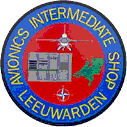F-16 avionics maintenance

RNLAF F-16 Avionics Maintenance
Maintenance Levels
The RNLAF has four levels of maintenance in general:
- 1st level maintenance (USAF: Organizational level)
- 2nd level maintenance (USAF: Intermediate level)
- 3rd level maintenance (USAF: Depot level)
- 4th level maintenance (industrial level)
The first three maintenance levels are comparable to the USAF maintenance levels. In practice, both sets of
terms are used indifferently.
On & Off Equipment
F-16 maintenance is based on so called on-equipment and off-equipment maintenance. By "repair-by-replacement" actual maintenance on the aircraft itself (on-equipment) can be reduced, since the F-16 consists of quickly removable modules that can be replaced on the flight line (hence, the term Line Replaceable Units). Also, most Line Replaceable Units (LRUs) use Self Tests (ST) and Built-In Tests (BIT) to isolate failures. LRUs removed from the aircraft are being repaired at another location (off-equipment), away from the aircraft.
This not only reduces repair time on the aircraft, but also decreases the influence of other shops at other levels of maintenance on the actual aircraft status.
Organizational Level
After each flight the pilot reports any malfunction to his debriefer. In the analysis of the problems reported a Fault Reporting manual is used. This manual contains the technical information for each of the systems needed to detect and report a Pilot Detectable Fault. An avionics repair party is sent to the aircraft to fix the problem on the aircraft using the information and the reported fault code of the debriefer and information derived from the Fault Isolating manual. In most cases the reported avionics problem can be solved by replacing one or more Line Replaceable Units, after which the aircraft can return to its operational tasks.
The on-equipment repair team is part of the Organizational or First level of maintenance.
Intermediate Level

Any avionics Line Replaceable Unit that was removed at the Organizational level will be offered for repair to the Intermediate or Second level maintenance. This level of maintenance is off-equipment maintenance, away from the aircraft. Traditionally, this task was performed by the F-16 Avionics Intermediate Shop (AIS), situated on the air base. Since the F-16 originally operated from four air bases (Leeuwarden, Twenthe, Volkel, and Gilze-Rijen - the latter one no longer in use as an F-16 base), there were initially four F-16 Avionics Intermediate Shops.
In the early 90s the decision was made to alter this maintenance concept. Two of the existing avionics shops (at Leeuwarden and Volkel) were to be decommissioned and two (Gilze-Rijen/Twenthe) were to be centralized on a single location. This was to be achieved around the same time the first Mid-Life Update F-16 aircraft were to be delivered. Together with additional test equipment for the Mid-Life Update F-16 this was to form the Dedicated Off-equipment Workcenter (DOW) as part of the Air Force's Electronic Materiel Depot.
Depot Level
Removed Shop Replaceable Units as well as Line Replaceable Units that can not be repaired at Intermediate level are offered to the Electronic Matériel Depot. Not all SRUs are repaired by the RNLAF Electronic Matériel Depot. In May 1979 the F-16 Avionics Depot Agreement (ADM) was signed between The Netherlands, Norway, and Denmark, controlling the Depot level maintenance for SRUs. Each of the countries — all part of the European Participating Air Forces (EPAF) — is responsible for a part of the SRUs:
- Netherlands
- Analog Test Station (ATS)
- Norway
- Microwave Test Station (MTS)
- Denmark
- Digital Test Station (DTS)
The advantage of this division is that the cost of all the test equipment is carried by all three countries. The Danish air force also acquired a test facility for electronic components of the SRUs, which makes fault isolation and problem solving more efficient.
In the case an SRU can not be repaired at Depot level, the RNLAF can rely on the industry, which makes up for the Fourth level of maintenance.